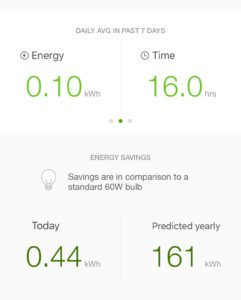Every night at 11.30pm something changes at my house. Without any human intervention, the smart lights from the front garden to the upstairs landing reduce their power consumption or switch off completely.
If you are still awake after 11.30pm you might need to ask the Smart Home Assistant to turn a light back on, or increase the brightness, but usually this timing works until dawn starts to break and the remaining “night-lights” switch from 10% to completely OFF.
This was an unintended benefit of my summer hobby to start introducing smart devices into our house. I’d like to say I started the project with the intention of saving the planet, but in truth, security and geekiness were my main drivers. However, I think it demonstrates that you can still get business and lifestyle benefits from technology, while also reducing energy consumption and improving the planet.
Energy Readings and Measurement
These particular smart bulbs also provide a measure of the energy use and a comparison with a 60W bulb.
While the accuracy of these figures might be debatable, there is little doubt that reducing the brightness of the bulb to 10% overnight uses less energy than 100%.
It also takes the ‘thinking’ out of energy saving, as the lights are scheduled to automatically switch off in the morning.
Other Smart Devices
There’s been an increase in the use of smart-thermostats recently, with Google and British Gas both entering the market through acquisitions of smart technology which enables you to manage your heating – even when you are not in. Some of these devices have also incorporated Artificial Intelligence (AI) to learn your habits and make energy saving designs on your behalf.
Unfortunately, I haven’t got that far yet, but we have some smart plugs which can be applied to any normal 3-pin plug. This means that you can control lamps, fish tanks, tortoise houses, desk fans etc., in the same way.
Setting a schedule for them to turn on or off, and getting individual energy reading for each device.
Remote Energy Management
Now my real interest in these smart-devices is the ability to control them remotely, via a mobile phone app. Together with the battery-powered Netgear Arlo Security cameras, you can see what’s happening at home, and adjust energy settings appropriately.
This is great for many reasons, but mainly for showing off!

Measurable Improvements
Above are just a few examples of what can be done at home, but when you apply that to a business setting, the savings can be even bigger. Most importantly you can measure energy use, allowing you to get a better grasp on the energy efficiency of your organisation’s processes.
Taking an energy baseline measurement regularly will help determine if your energy initiatives are having an effect, and smart devices can not only assist in reducing consumption but also help you measure it.
Carbon Footprint
Organisations of any size can measure their carbon footprint, take action to reduce their carbon emissions (direct and indirect) and offset the remaining carbon, by supporting one of the many schemes available.
Assent Risk Management has Consultants who can help you implement an Energy Management System (ISO 50001) measure Carbon Footprint, and much more. Contact Us for Details.


